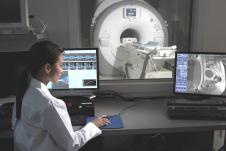
August 24, 2012 — On August 20, 2012, InSightec announced it received approval from the U.S. Food and Drug Administration (FDA) to begin Phase I clinical trials evaluating the use of its ExAblate Neuro system for the treatment of patients with tremor-dominant Parkinson’s Disease (PD). This device is the first clinical system to use magnetic resonance- (MR) guided focused ultrasound (MRgFUS) through an intact skull, offering noninvasive transcranial treatment without any incisions or ionizing radiation.
The ExAblate Neuro system is designed to alleviate the cardinal clinical features of PD through noninvasive deep-lesioning of the brain. While the concept of using focused ultrasound for noninvasive treatment of brain disorders has been recognized for many years, InSightec's Eyal Zadicario, vice president of research and development, said that vast technical barriers had to be overcome to enable this modality to become a reality.
Lesioning has been an accepted technique to treat the symptoms of PD for years; however, InSightec’s ExAblate Neuro device offers the first noninvasive lesioning treatment in clinical trials to date. This treatment boasts improved accuracy, as MR images are used to reconstruct the skull and this data, in turn, is used to configure the ultrasound beams to properly focus on the targeted lesion.
The Phase I clinical trial for ExAblate Neuro will be sponsored in collaboration with the Focused Ultrasound Foundation of Charlottesville, Va., where researchers have already treated 15 essential tumor patients successfully. Preclinical studies conducted at the Focused Ultrasound Foundation, as well as Arizona State University, UCLA and Brigham and Women’s Hospital, indicate the mechanical effects of ultrasound alone may be sufficient to both excite and suppress neuronal circuits.
PD is caused by the death of nerve cells in the brain, resulting in the ever-increasing impairment of cognitive and motor functions over time. This chronic, degenerative neurological disorder affects at least 1 million people in the U.S. and more than 5 million people worldwide. According to the National Parkinson Foundation, 50,000 to 60,000 new cases of Parkinson’s are diagnosed each year in the U.S. alone, making it the 14th leading cause of death. The number of people suffering from PD is expected to double by 2030, with the greatest growth in the number of cases coming from developing Asian countries, particularly China and India, where the number of elderly people is expected to see the biggest increase. If approved in the U.S., this device will likely be introduced into other markets quickly to meet this need.
There is no known cure for PD and there are few therapies available for patients suffering from its symptoms. Presently, most treatment options are limited to drug therapy and surgery, including deep brain stimulation and direct lesioning. While each of these approaches has been proven to show some symptomatic improvement, their effectiveness is limited and side effects discouraging. Drug therapy techniques, even at optimal intervals and dosages of medication, show diminishing effectiveness as the disease progresses and ultimately fail to promote good motor control in late-stage PD.
Deep brain stimulation, or neurostimulation, is the most common surgical intervention used; however, this technique is complicated, as well as very invasive. Other options include radiofrequency ablation, another invasive technique, as well as radiosurgery, which has adverse side effects related to its use of ionizing radiation. As MRI machines become increasingly available to patients around the world, focused radiation offers a noninvasive means of accessing hard-to-reach areas of the body. It is expected that such techniques will become progressively more accurate and less expensive as technologies improve.
While deep brain stimulation may be on the way out for the treatment of PD, the neurostimulation market was valued at more than $1.8 billion in 2010 across all indications, with Medtronic leading the way with a 54 percent share of the global market. It is expected that this market will grow at a compound annual growth rate (CAGR) of 14 percent to reach $4.7 billion by 2017, to match the ever-increasing elderly population and consequent rise in disease incidence.
There are many future treatments being developed for PD besides MRgFUS, including gene therapy and the use of stem cells. Gene therapy offers a means of introducing normal genes into people with certain disorders to overcome the effects of defective genes; however, this therapy is not yet available and is in the early stages of research. The use of stem cells to replace damaged cells with healthy, dopamine-producing ones is steadily progressing; however, it will be at least 5 to 10 years before clinical trials using stem cell therapy to treat PD will be considered.
Beyond working to treat indications of PD, additional research using MRgFUS is being conducted for chronic neuropathic pain, targeted drug delivery, uterine fibroids, adenomyosis and sonothrombolysis for acute ischemic stroke. MRgFUS technology allows physicians to visualize the body anatomy, plan the procedure, adjust and control the treatment and monitor the outcome – all in real time. As technologies develop, this treatment will have applications across multiple clinical disciplines. InSightec is currently testing MRgFUS for multiple indications and will need to push its Neuro product through clinical trials to stay ahead of its competitors, as they are slowly expanding their markets to target this population as well.
For more information: www.insightec.com
This article was written by GlobalData medical devices analyst, Rob Littlefield.


 December 23, 2025
December 23, 2025 









